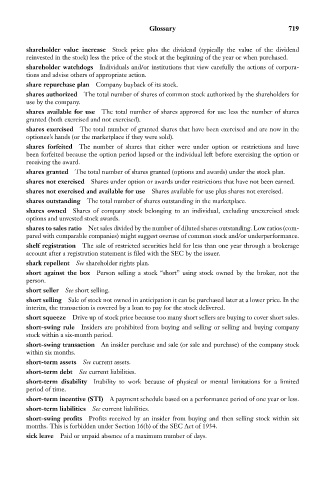Page 734 - Bruce Ellig - The Complete Guide to Executive Compensation (2007)
P. 734
Glossary 719
shareholder value increase Stock price plus the dividend (typically the value of the dividend
reinvested in the stock) less the price of the stock at the beginning of the year or when purchased.
shareholder watchdogs Individuals and/or institutions that view carefully the actions of corpora-
tions and advise others of appropriate action.
share repurchase plan Company buyback of its stock.
shares authorized The total number of shares of common stock authorized by the shareholders for
use by the company.
shares available for use The total number of shares approved for use less the number of shares
granted (both exercised and not exercised).
shares exercised The total number of granted shares that have been exercised and are now in the
optionee’s hands (or the marketplace if they were sold).
shares forfeited The number of shares that either were under option or restrictions and have
been forfeited because the option period lapsed or the individual left before exercising the option or
receiving the award.
shares granted The total number of shares granted (options and awards) under the stock plan.
shares not exercised Shares under option or awards under restrictions that have not been earned.
shares not exercised and available for use Shares available for use plus shares not exercised.
shares outstanding The total number of shares outstanding in the marketplace.
shares owned Shares of company stock belonging to an individual, excluding unexercised stock
options and unvested stock awards.
shares to sales ratio Net sales divided by the number of diluted shares outstanding. Low ratios (com-
pared with comparable companies) might suggest overuse of common stock and/or underperformance.
shelf registration The sale of restricted securities held for less than one year through a brokerage
account after a registration statement is filed with the SEC by the issuer.
shark repellent See shareholder rights plan.
short against the box Person selling a stock “short” using stock owned by the broker, not the
person.
short seller See short selling.
short selling Sale of stock not owned in anticipation it can be purchased later at a lower price. In the
interim, the transaction is covered by a loan to pay for the stock delivered.
short squeeze Drive up of stock price because too many short sellers are buying to cover short sales.
short-swing rule Insiders are prohibited from buying and selling or selling and buying company
stock within a six-month period.
short-swing transaction An insider purchase and sale (or sale and purchase) of the company stock
within six months.
short-term assets See current assets.
short-term debt See current liabilities.
short-term disability Inability to work because of physical or mental limitations for a limited
period of time.
short-term incentive (STI) A payment schedule based on a performance period of one year or less.
short-term liabilities See current liabilities.
short-swing profits Profits received by an insider from buying and then selling stock within six
months. This is forbidden under Section 16(b) of the SEC Act of 1934.
sick leave Paid or unpaid absence of a maximum number of days.

